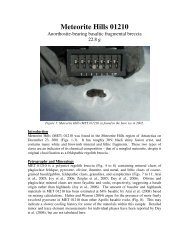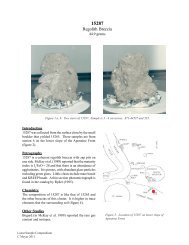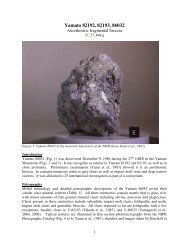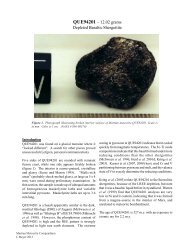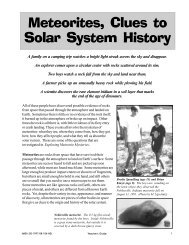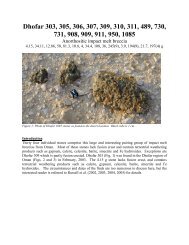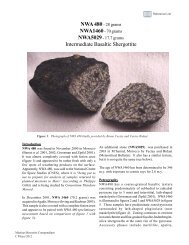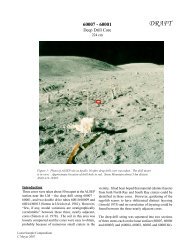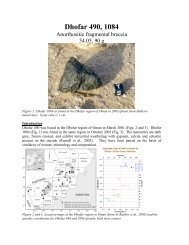Moore County Unbrecciated Cumulate Eucrite, 1.88 kg
Moore County Unbrecciated Cumulate Eucrite, 1.88 kg
Moore County Unbrecciated Cumulate Eucrite, 1.88 kg
You also want an ePaper? Increase the reach of your titles
YUMPU automatically turns print PDFs into web optimized ePapers that Google loves.
Duke and Silver (1967) plotted the bulk composition of <strong>Moore</strong> <strong>County</strong> on a normative MgSiO3-FeSiO3-<br />
CaAl2Si2O8 (enstatite-ferrosilite-anorthite) ternary diagram; whereas most eucrite bulk compositions plot<br />
near the pyroxene-plagioclase boundary curve (suggestive of coincident crystallization of pyroxene and<br />
plagioclase), <strong>Moore</strong> <strong>County</strong> falls within the anorthite stability field, and is thus termed a “feldsparcumulate”<br />
eucrite.<br />
Whole-rock REE data from Table 3 is plotted in Figure 12, normalized to chondritic values. REE patterns<br />
for <strong>Moore</strong> <strong>County</strong> show overall enrichment (4-6x) from chondritic values, with a slight increase from<br />
LREE to HREE enrichment and a noticeable positive Eu anomaly. These values are consistent with the<br />
cumulate, plagioclase-rich nature of <strong>Moore</strong> <strong>County</strong>.<br />
Mittlefehldt (1987) investigated volatile alkali contents in <strong>Moore</strong> <strong>County</strong> and other cumulate eucrites,<br />
and compared them to an average of normalized cosmic abundances of refractory elements in each<br />
sample (referred to as AHIR = average highly incompatible refractory). He found that AHIR increased<br />
among the feldspar-cumulate eucrites with increasing Fe content (consistent with fractionation from a<br />
single magma), but saw that K/AHIR and Rb/AHIR decreased with similar increases in Fe, suggesting<br />
volatile loss and degassing during magma cooling and crystallization. (As <strong>Moore</strong> <strong>County</strong> is the most Ferich<br />
cumulate eucrite, this suggests more volatile loss in <strong>Moore</strong> <strong>County</strong> relative to the other cumulates.)<br />
Radiogenic Isotopes: The first reported age date for <strong>Moore</strong> <strong>County</strong> was a K-Ar age of 3.23 ± ~0.2 Ga<br />
(Geiss and Hess, 1958), who posited that this age could represent crystallization or the last serious<br />
heating event experienced by the rock. This and other variable K-Ar ages (e.g., 3.5 Ga: Heymann et al,<br />
1968) suggest the likelihood of argon loss post-crystallization for <strong>Moore</strong> <strong>County</strong>. However, careful<br />
correction of argon isotopic character in <strong>Moore</strong> <strong>County</strong> can still provide important constraints on the<br />
crystallization and cooling history, as the most recently-obtained age (4.460 Ga: Shukolyukov and<br />
Begemann, 1996b) is coincident with other Sm-Nd and Lu-Hf age dates (see below).<br />
Other early ages for <strong>Moore</strong> <strong>County</strong> include Rb-Sr and Sr-Sr ages for HED achondrites as a whole (4.5 Ga:<br />
Gast, 1962; 4.39 ± 0.26 Ga: Papanastassiou and Wasserburg, 1969), as well as a (U,Th)- 4 He age, specific<br />
to <strong>Moore</strong> <strong>County</strong>, of 5.0 ± 0.2 Ga (Heymann et al, 1968). However, as noted by Carver and Anders<br />
(1976), <strong>Moore</strong> <strong>County</strong> has a significant 4 He excess (estimated at 580 x 10 -8 STP/g using 4.56 Ga as the<br />
crystallization age, or 14% of the total 4 He), and thus this (U, Th)- 4 He age does not have any significance<br />
to the history of the meteorite.<br />
14




